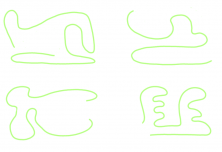Curved lines and straight lines. This week’s post will teach you how to differentiate between open and closed curves.
The first item on our agenda is: Do you know what a curve is? A curve is a succession of points that constantly change direction, in other words, it isn’t straight.
The image below shows a succession of points that always go in the same direction. When the points are connected, they form a straight line.

In the image below, we can see a succession of points that constantly change their direction. When these points are connected, they form a curve.

Within the curved lines, we can find open and closed curves.
The open curves are the ones that are impossible for us to reach the starting point again if we were to follow the succession of points with a pencil, without lifting it from the paper.
This is an example of an open curved line:

The closed curves are the ones where we can return to the starting point if we were to follow the dots with a pencil, without lifting it from the paper.
This is an example of a closed curved line:

Here are some other examples of open and closed curves:
Open Curved Lines:

Closed Curved Lines:

It’s easy, right? If you enjoyed this post and learned how to differentiate between open and closed curves, share it with your friends and classmates so that they can learn about them, too.
Register for Smartick and try a free 15-day trial!
Learn More:
- Elementary Geometry – Open Lines
- Learn More about Straight Lines
- Lines: What They Are, Types, and Examples
- How to Identify Open and Closed Polygonal Lines
- Geometric Figures and Straight Lines








Thank you it really help me very much